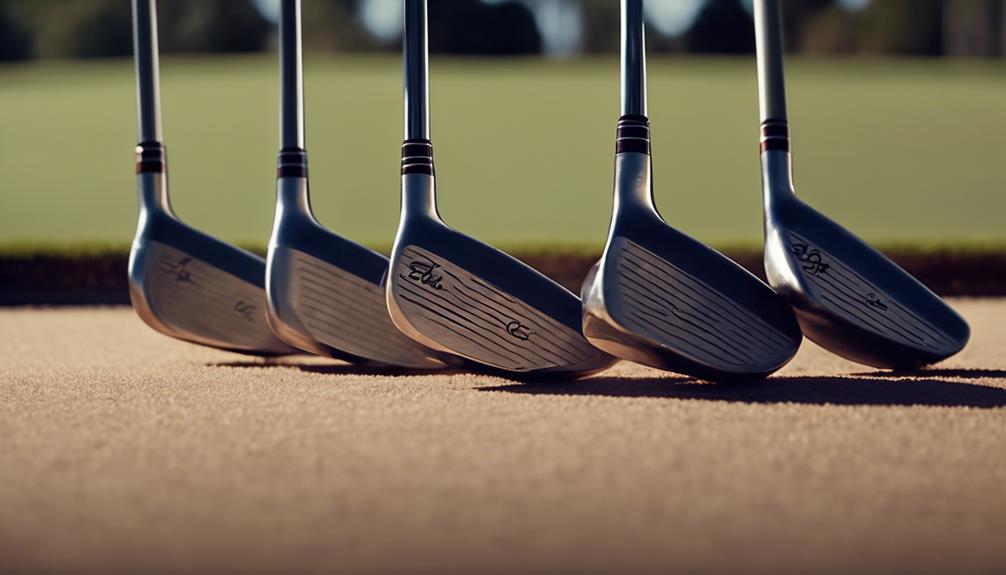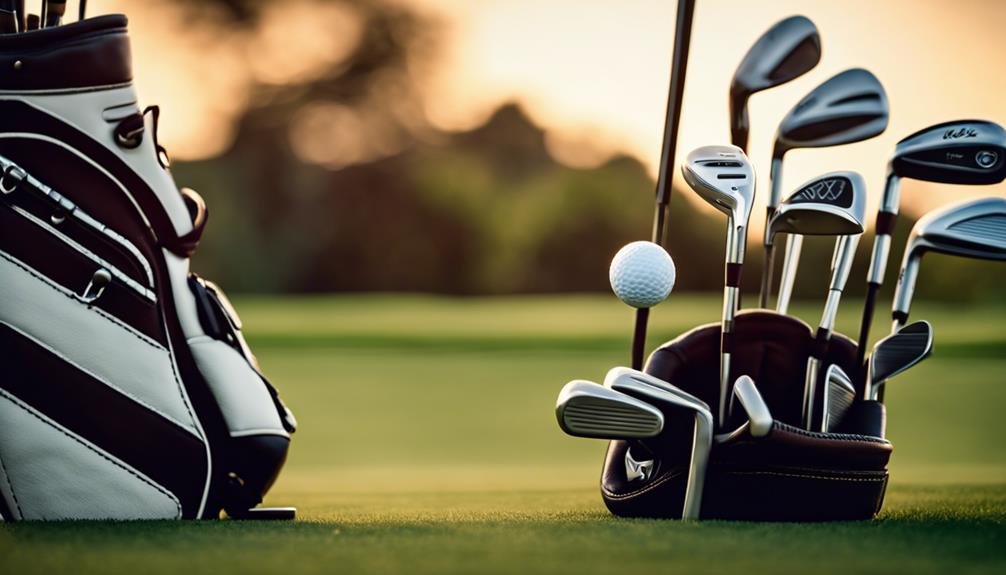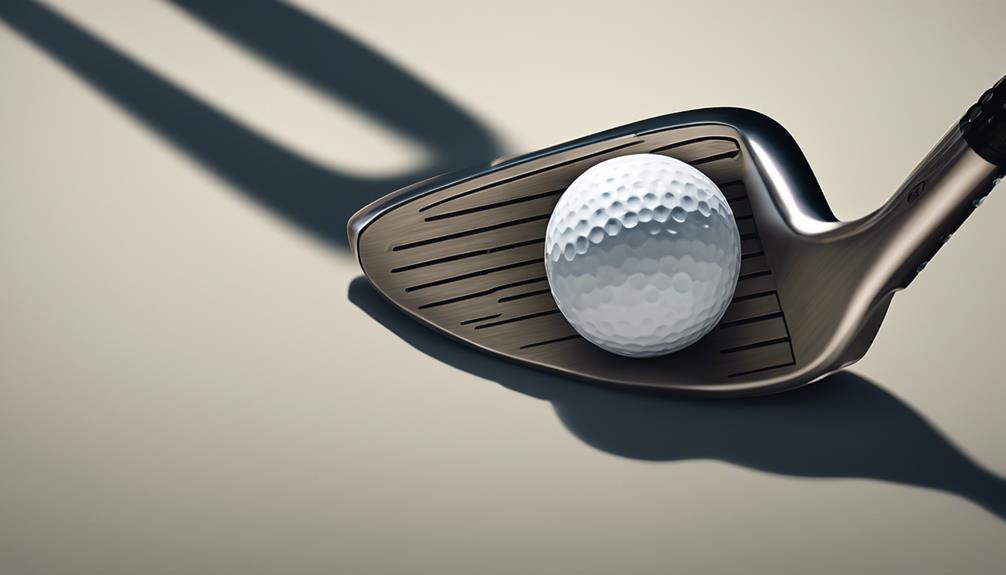- 7 Top Flite Golf Clubs XL for Improved Performance - September 28, 2024
- Top Flite Golf Clubs: Top 5 Reasons to Choose Them - September 28, 2024
- Top 3 Golf Club Fitters for a Perfect Swing - September 28, 2024
You'll find the right golf clubs for your game by considering a combination of factors, including your playing style, budget, and personal preferences. With 70% of golfers playing with ill-fitting clubs that can have a significant impact on their performance, it's essential to get it right. Start by using an iron selector tool to pinpoint the best irons for your needs. Then, consider clubhead materials, shaft flex options, and impact on forgiveness, distance, and feel. Finally, explore different club types, including drivers, fairway woods, hybrids, irons, and wedges, to understand their strengths and weaknesses. Now, discover how to find the perfect fit for your game.
Key Takeaways
- Use an iron selector tool to find the best irons based on your playing style, handicap, and longest comfortable iron.
- Consider factors like clubhead material, shaft flex, and length to ensure the right fit for your game.
- Get professionally fitted to find clubs that match your swing speed, style, and body measurements.
- Research and read reviews to find clubs that suit your budget, skill level, and personal preferences.
- Try out different clubs before purchasing to ensure the best performance and feel for your game.
Irons Selector Tool
Utilizing TaylorMade's innovative Irons Selector Tool, you can pinpoint the best golf irons tailored to your unique playing style and game requirements. This cutting-edge technology considers various factors, including your score, handicap, and longest comfortable iron, to recommend the perfect golf clubs for your game.
By analyzing these aspects, the tool simplifies the iron selection process, helping you make informed decisions about your iron choices.
The Irons Selector Tool is designed to assist you in choosing the right irons that suit your playing style. Whether you're a beginner or an experienced golfer, this tool provides a personalized recommendation, ensuring you find the best golf irons that meet your specific needs.
By using the tool, you'll gain a deeper understanding of your game, allowing you to make data-driven decisions about your equipment.
With the Irons Selector Tool, you'll be able to identify the perfect golf clubs that will help you improve your game and take your skills to the next level.
Golf Club Fundamentals
When selecting the right golf clubs, you'll want to take into account the club head materials, as they can impact the weight, durability, and overall feel of your clubs.
You'll also need to think about shaft flex options, which can greatly influence your swing tempo and ball flight.
Club Head Materials
As you explore the world of golf clubs, you'll find that clubheads are typically crafted from a select few materials, including stainless steel, titanium, or a strategic combination of both. The choice of club head material can notably impact the feel, forgiveness, and distance of the golf club.
Stainless steel clubheads offer affordability and forgiveness, making them an excellent option for beginners or those on a budget. Titanium, on the other hand, is lighter and provides more distance, making it a popular choice for drivers. The lightweight properties of titanium allow for increased swing speed, resulting in longer drives.
Understanding the characteristics of different club head materials can help you select the right clubs for your individual playing style. If forgiveness is a priority, stainless steel might be the way to go. If you're looking to maximize distance, titanium could be the better option.
Shaft Flex Options
You'll need to pair your chosen club head material with a shaft that matches your swing speed and style, which is where shaft flex options come into play. The right shaft flex can optimize distance, accuracy, and feel in each shot, making it an essential factor in club selection.
When selecting a shaft flex, consider your swing speeds and player preferences. Here's a breakdown of the common shaft flex options:
| Shaft Flex | Suitable For |
|---|---|
| Regular | Mid-to-slow swing speeds (60-80 mph) |
| Stiff | Mid-to-fast swing speeds (80-100 mph) |
| Extra Stiff | Fast swing speeds (100+ mph) |
Keep in mind that graphite shafts are lighter and can help increase swing speed, while steel shafts tend to be stiffer and offer more control. Ultimately, the ideal shaft flex aligns with your playing style, swing characteristics, and budget considerations. If you're unsure, consider a professional club fitting to determine the perfect shaft flex for your game. By finding the right shaft flex, you'll realize your full potential on the course.
Choosing the Right Clubs

When selecting the right golf clubs, you'll need to evaluate several key factors that impact your game.
You'll want to assess your individual playing style, including your swing speed and tempo, as well as the specific clubs that will best complement your strengths and weaknesses.
Club Selection Factors
Selecting the right golf clubs requires careful consideration of multiple factors, including your skill level, budget, and personal preferences, to guarantee a set that complements your game.
When choosing the best clubs for you, consider your skill level – beginners may benefit from more forgiving clubs, while experienced players may prefer more precise ones. Your budget is also essential, as high-quality clubs can be costly. Additionally, think about your personal preferences, such as the feel and look of the clubs.
Shaft flexibility, material, and length are also important considerations. Do you prefer a stiff or flexible shaft? What about the clubhead material – titanium, steel, or graphite? Getting a professional club fitting can greatly impact your choice, as a custom fit can enhance your overall game.
Research different brands, models, and read reviews to make an informed decision. Don't be hesitant to try out clubs before purchasing to make sure they suit your playing style.
Golf Swing Considerations
As you prepare to select the appropriate golf clubs, your swing speed and style take center stage, demanding careful thought to ensure the perfect match between club and golfer.
Your swing speed, in particular, plays a vital role in determining the ideal shaft flex for your clubs. Faster swings require stiffer shafts for better control, while slower swings benefit from more flexible shafts. You'll need to explore options like regular, stiff, and extra stiff to find the right fit.
The clubhead material is another important factor to examine. Stainless steel and titanium are popular choices, each offering unique benefits in terms of forgiveness and distance. However, it's crucial to test out different clubs to experience their performance and find the best fit for your swing.
Don't overlook the opportunity to get a professional club fitting, as it can greatly enhance your game by ensuring the right clubs match your swing and body measurements.
Individual Playing Style
Determine your individual playing style by evaluating your swing speed, shot tendencies, and skill level. These factors will greatly influence your club choice.
Your swing speed, for instance, will affect the type of driver you need. Faster swingers require less loft and more forgiveness.
Your shot tendencies, such as a draw or fade, will also impact the clubhead design and shaft flexibility that suits you best.
Additionally, your skill level will dictate the level of forgiveness and accuracy you need from your irons and wedges.
Types of Golf Clubs
You'll encounter five primary categories of golf clubs in your bag, each designed to tackle specific shots and scenarios. Understanding these categories is essential in selecting the right clubs for your game.
Here are the main types of golf clubs you'll need to know:
- Drivers: Ideal for long shots off the tee on par 4 and par 5 holes, drivers have the largest clubheads with the lowest loft.
- Fairway Woods: Smaller than drivers, fairway woods are designed for shots from the fairway or rough, and are made of steel, titanium, or composite materials.
- Hybrids: Combining elements of woods and irons, hybrids feature clubheads shaped like woods but with lengths and lofts similar to irons, making them a great alternative to long irons.
- Irons: Versatile clubs used on most holes, irons cover chip shots, mid-range shots, and long shots on par 3s, making them an essential part of your bag.
As you explore these categories, consider your individual playing style and the shots you struggle with most. By understanding the strengths and weaknesses of each club type, you'll be better equipped to choose the right clubs for your game and improve your overall performance.
Irons and Wedges Explained

As you consider your iron selection, you'll need to factor in variables like loft and distance to make sure you're getting the right club for your swing.
You'll also want to think about the type of iron that suits your game, whether that's a perimeter-weighted club for easier hits or a more specialized option for precise control.
When it comes to wedges, understanding bounce angles is important for mastering tricky shots out of sand or rough.
Irons Selection Factors
When selecting irons, golfers must consider key factors, including loft angle, club type, and perimeter weighting, to optimize their performance on the course.
To make an informed decision, you should consider the following:
- Loft and lie: The angle at which the clubface meets the ball affects the trajectory and distance of your shots. Confirm the loft and lie of your irons suit your swing style.
- Club type: Cavity back, blade, and game improvement irons cater to different skill levels and playing styles. Choose a club type that aligns with your game.
- Perimeter weighting: This feature redistributes weight to the club's perimeter, increasing forgiveness and making it easier to get the ball airborne.
- Center of gravity: A strategically positioned center of gravity can enhance the club's performance by promoting a more consistent swing.
Irons Loft and Distance
Now that you've considered the key selection factors, it's time to explore how irons' varying lofts impact the ball's trajectory and distance.
You'll notice that irons with lower lofts, such as a 3-iron with around 20 degrees, produce longer shots with a lower ball trajectory, often reaching distances of approximately 200 yards. On the other hand, irons with higher lofts, like Pitching Wedges (PW) and Sand Wedges (SW) with lofts of around 50-56 degrees, result in higher flights but shorter distances of about 100 yards.
The lower the golf club number, the lower the ball flight and the further it will travel. However, this comes at the cost of control, making it more challenging to hit accurately. Perimeter-weighted irons, which have more weight around the head's perimeter, can help mitigate this issue by making it easier to hit and launch the ball into the air.
Understanding the relationship between irons loft and distance is essential in selecting the right clubs for your game. By considering your swing style and desired ball trajectory, you can choose irons that optimize your performance and help you achieve mastery on the course.
Wedges Bounce Angles
You'll find that the bounce angle of a wedge plays a crucial role in preventing the club from digging into the ground or snagging in sand and rough, allowing for a smoother, more controlled swing.
When selecting wedges, it's crucial to take into account the bounce angle and loft to make sure you're getting the right club for your game. Here's a breakdown of the different types of wedges and their typical lofts:
- Pitching Wedge (PW): 46-50 degrees, ideal for shots around 120 yards into the green.
- Gap or Approach Wedge (GW) or (AW): 50-55 degrees, filling the gap between your PW and SW.
- Sand Wedge (SW): 54-58 degrees, perfect for escaping bunkers and rough.
- Lob Wedge (LW): 60-64 degrees, designed for high flights from short distances.
Choosing the right wedge can greatly enhance your score and performance on the course.
Drivers and Fairway Woods
Teeing off with confidence demands the right club, and drivers, with their massive clubheads and lengthy shafts, are specifically designed to deliver maximum distance and accuracy on par 4 and par 5 holes. When choosing your golf drivers, consider clubhead material, size, and loft. You'll find drivers with clubheads made of steel, titanium, or composite materials, each offering unique benefits.
| Club Type | Clubhead Material | Loft |
|---|---|---|
| Driver | Steel, Titanium, Composite | 7-12° |
| Fairway Wood | Steel, Titanium, Composite | 13-20° |
| Hybrid | Steel, Titanium, Composite | 17-24° |
Fairway woods, on the other hand, feature smaller clubheads and are used for shots off the fairway or tee. They're ideal for shots requiring more accuracy than distance. When selecting fairway woods, consider the clubhead material and size, as well as the loft, which will affect the trajectory of your shot. By understanding the characteristics of drivers and fairway woods, you'll be better equipped to choose the right club for your game, ensuring you drive with confidence and accuracy.
Hybrid Clubs and Options

As you move beyond drivers and fairway woods, you'll find that hybrid clubs offer a unique solution for shots that require both forgiveness and distance. By combining elements of both woods and irons, hybrid clubs provide a more forgiving and distance-enhancing option for your game.
Here are four key benefits of hybrid clubs:
- Easier to get airborne: With a deeper face-to-back design than regular irons, hybrid clubs make it easier to get the ball airborne, even from difficult lies.
- Smooth edges for rough shots: Hybrid clubs feature smooth edges that prevent dragging through thick grass, making them perfect for shots from the rough.
- Forgiveness and distance: Hybrid clubs offer a unique combination of forgiveness and distance, making them ideal for shots that require both.
- Versatility and ease of use: While not necessary for all golfers, hybrids can provide versatility and ease of use on the course, especially for those who struggle with long irons.
When choosing the right hybrid club, consider your swing style, shot preferences, and the specific situations you encounter on the course. By selecting the right hybrid club, you can enhance your performance and take your game to the next level.
Wedges and Putters Guide
Precision and control are paramount when it comes to maneuvering the green, and that's where wedges and putters come into play, serving as the ultimate scoring tools in your golfing arsenal.
When selecting wedges, you'll want to contemplate the Pitching Wedge and Sand Wedge, which boast lofts ranging from 50-56 degrees, ideal for high flights but shorter distances. For those high, short shots around the green, the Lob Wedge, with its 60-64 degree loft, is the perfect choice.
When it comes to putters, you'll be spoiled for choice, with options ranging in price from £10 to £200. Different types, such as Blade, Half-Mallet, and Mallet, cater to individual preferences. Putter lengths, typically ranging from 33' to 35', will also impact your feel and performance on the greens.
Choosing the right wedge and putter can notably enhance your score and overall game. By understanding your options and selecting the right tools, you'll be well on your way to mastering the green and taking your game to the next level.
Golf Club Buying Tips

When you're ready to upgrade your golfing arsenal, considering a few key factors will help you make informed decisions and get the most out of your new clubs.
To Choose the Right golf clubs for your game, follow these essential tips:
- Assess your skill level: Understand your strengths and weaknesses to determine the right clubhead material, such as stainless steel for forgiveness or titanium for distance.
- Consider shaft flexibility: Select a shaft that aligns with your playing style, whether it's regular, stiff, or extra stiff.
- Research clubhead materials: Weigh the pros and cons of different materials to find the best fit for your swing.
- Get a professional club fitting: This will guarantee your clubs are tailored to your swing and body measurements, providing peak performance.
Club Fitting Essentials
Your path to optimizing your golf game begins with a thorough understanding of club fitting essentials, a critical step in finding the perfect clubs tailored to your unique swing and playing style.
| Aspect | Importance | Impact on Performance |
|---|---|---|
| Swing Speed | Determines clubhead speed and ball flight | Affects distance and accuracy |
| Body Measurements | Influences club length and shaft flex | Impacts comfort and control |
| Playing Style | Affects clubhead design and loft | Influences shot shape and trajectory |
A professional club fitting session can help you enhance performance and consistency on the course. By analyzing your swing speed, body measurements, and playing style, a fitter can recommend the ideal club specifications for your game. This personalized approach ensures that your clubs are tailored to your unique needs, leading to better shot accuracy, increased distance, and overall improvement in your game. Don't settle for off-the-shelf clubs – invest in a club fitting session to take your game to the next level.
Golf Club Components

As you explore the world of golf clubs, understanding the individual components is important, and it all starts with the grip, shaft, hosel, clubhead, and lie angle, each playing an essential role in your overall performance.
Here's a breakdown of each component:
- Grip: The part of the club you hold onto during a swing, it's vital for maintaining control and consistency.
- Shaft: Connecting the grip to the clubhead, it affects the club's flexibility and weight, which in turn impact your swing tempo and accuracy.
- Hosel: The part of the clubhead where the shaft is attached, its design and construction can influence the club's overall performance.
- Clubhead: The part that makes contact with the ball, it comes in various shapes and materials, each designed to optimize distance, accuracy, and control.
Understanding these components is key to selecting the right golf clubs for your game. By recognizing how each part contributes to your overall performance, you'll be better equipped to make informed decisions when choosing your clubs.
Finding Your Perfect Clubs
With a solid understanding of golf club components, you're now ready to focus on finding the perfect clubs that fit your unique needs and preferences.
When searching for the ideal clubs, consider factors such as your skill level, budget, and clubhead material. Shaft flexibility, material, and professional fittings also play a vital role in selecting the right clubs.
Research different brands and models, read reviews, and consult with fellow golfers to gain valuable insights. It's important to try out clubs before purchasing to make sure they suit your playing style.
Don't be afraid to ask for professional fittings, as they can greatly impact your game. By considering these factors, you'll be able to make an informed decision and find clubs that enhance your overall golfing experience.
Frequently Asked Questions
How Do I Determine the Best Golf Clubs for Me?
To determine the best golf clubs for you, get a professional club fitting, which includes swing analysis, to identify ideal shaft options, and explore customization options, ensuring a precise match for your unique swing and playing style.
How Do I Choose Which Golf Club to Use?
When choosing a golf club, you'll consider club fitting pros and cons, weigh custom vs off-the-shelf options, research brand reputation, and analyze your swing to select the right club for your game, ensuring peak performance.
How to Choose Golf Clubs for Your Height?
When choosing golf clubs, you'll want to take into account your height to determine the ideal club length, then select the right shaft flex, grip size, and clubhead weight to optimize your swing mechanics and overall performance.
How Do You Know What Golf Clubs Fit You?
You determine if golf clubs fit you by undergoing swing analysis, custom fitting, and trial and error, while seeking professional advice to guarantee a precise match, optimizing your game through a data-driven approach.
Conclusion
You've made it to the end of our golf club guide! Now, you're equipped to find the perfect set for your game. Remember, 70% of golfers play with clubs that don't fit their swing, so don't be one of them!
Get fitted, consider your playing style, and don't be afraid to try out different clubs before making a purchase. With the right clubs, you'll be slicing your handicap in no time.
Happy golfing!




